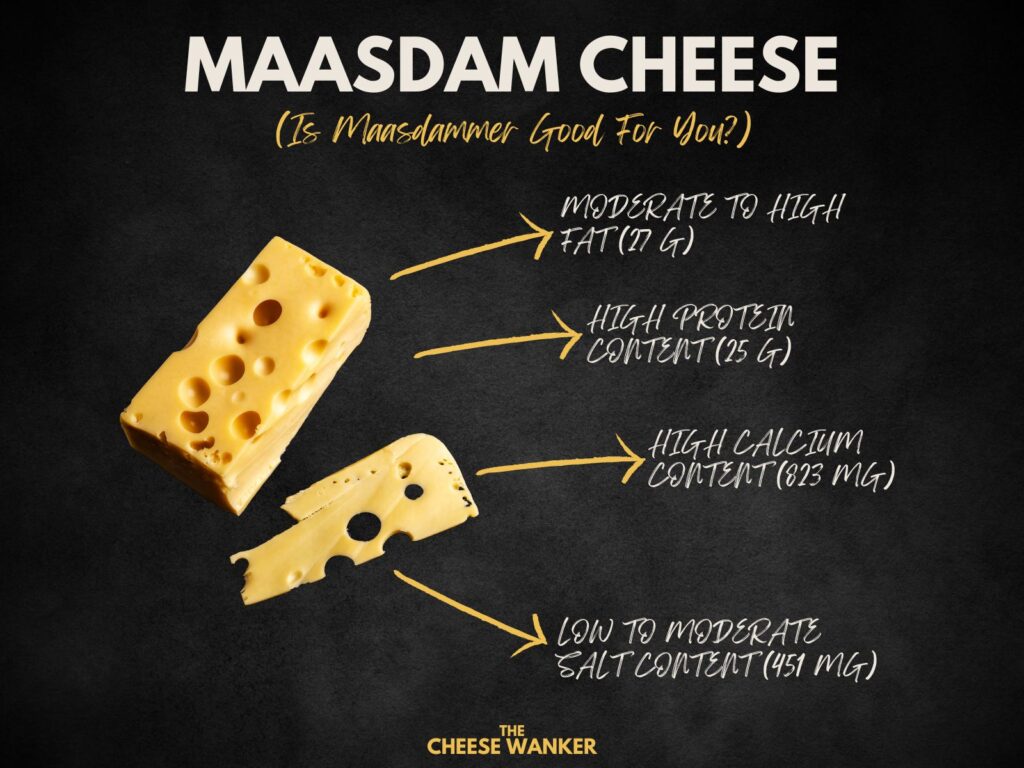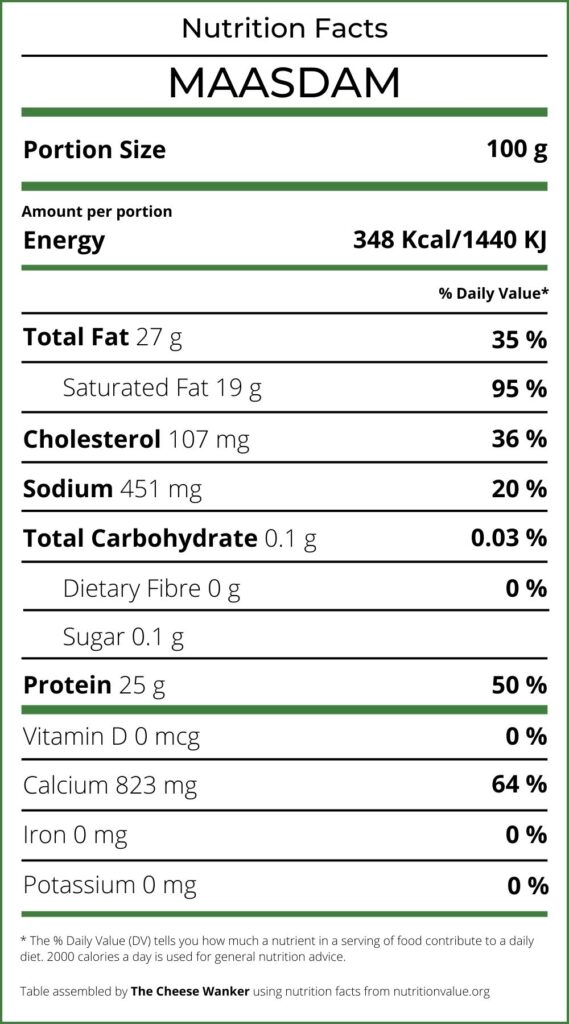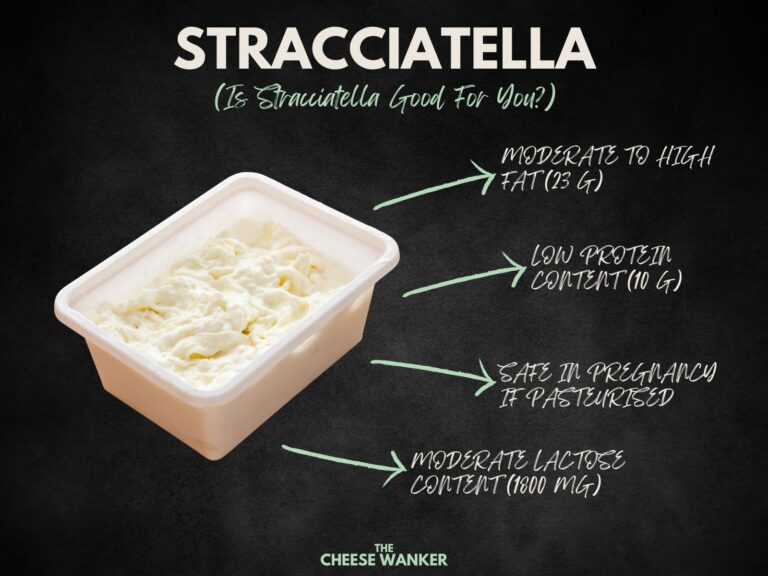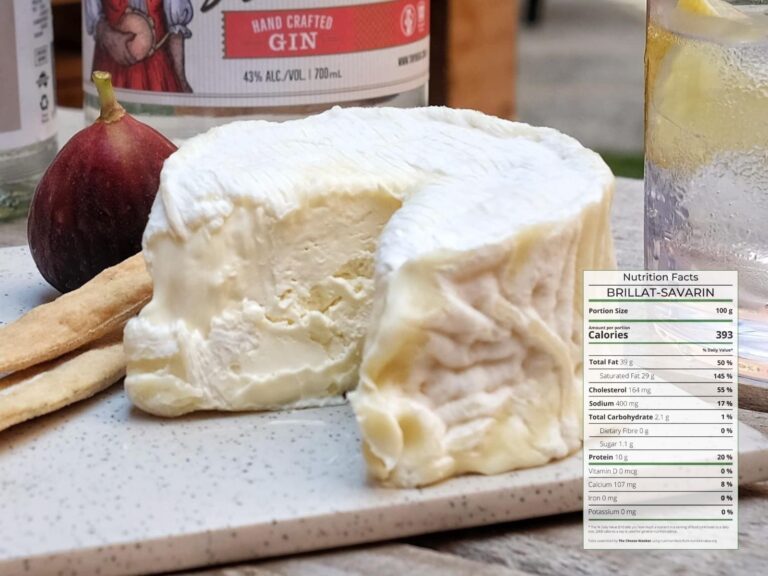In the Dutch cheese landscape, Maasdam stands out as a distinct and delightful option, appreciated for its unique flavour and holey texture. This semi-hard cheese has gained popularity worldwide for its mild and nutty taste. In this blog post, we delve into the nutrition facts of Maasdam, exploring its nutrient profile and its safety considerations for pregnancy and lactose intolerance.

SEE ALSO: Nutrition facts for popular world cheeses in The Cheese Wanker’s index →
What is Maasdam?
Hailing from the Netherlands, Maasdam is a pasteurised cow’s milk cheese renowned for its holey structure. Unsurprisingly, it was developed as a less expensive local alternative to Swiss Emmentaler.
In the Netherlands, it goes by the name Maasdammer, highlighting its strong ties to the region. And it draws its name from the village of Maasdam in South Holland, where it was first developed.
Its mild, nutty flavour profile sets it apart, but Maasdam’s versatility shines brightest through its culinary applications. Whether sliced for sandwiches, melted in fondues or paired with fruits on a cheese board, its amiable nature and holey texture make it a crowd-pleaser.
Nutrition fact sheet for Maasdam

Nutritional review for Maasdam
Eating healthy plays a pivotal role in maintaining overall well-being and preventing chronic diseases. A balanced and nutritious diet provides our bodies with essential vitamins, minerals, and macronutrients, fuelling optimal physical and cognitive function.
With this in mind, let’s have a look at some of the key nutrition facts for Maasdam.
Calorie Count
At 348 calories per 100 grams, Maasdam proves to be a calorie-dense option. However, it’s crucial to recognise that the quality of these calories often outweighs the mere quantity. Rich in essential nutrients, Maasdam contributes significantly to one’s overall nutritional intake.
Fat Content
With a hefty 27 grams of fat per 100 grams, Maasdam falls into the high-fat category. However, the key lies in understanding the types of fats present.
Predominantly composed of saturated and unsaturated fats, this cheese offers a balanced lipid profile, contributing to both energy provision and cardiovascular health.
You can learn more about the different types of fat in cheese and which cheeses have the lowest fat content here.
Protein Content
Boasting an impressive 25 grams of protein per 100 grams, Maasdam stands as a high-protein option. The protein found in this cheese comprises a variety of essential amino acids, making it a valuable dietary source.
Proteins are fundamental for muscle building, immune function and overall cellular health.
Want to find out which cheeses have the highest protein content? Click here for our blog post covering cheeses with the highest protein content.
Cholesterol Content
With 107 milligrams of cholesterol per serving, Maasdam prompts the question: Is dietary cholesterol inherently harmful?
Contrary to common belief, emerging research suggests that dietary cholesterol may not significantly impact blood cholesterol levels in most individuals. Therefore, Maasdam can be enjoyed without undue concern about its cholesterol content.
You can learn more about the impact of dietary cholesterol on blood cholesterol levels in our dedicated post here.
Salt Content
At 451 milligrams of salt per 100 grams, Maasdam falls within the low to moderate salt range. Surprisingly, this is lower than its cousin, Gouda.
The mild salty taste in Maasdam is attributed to the brining process during its production. Of course, it’s crucial to monitor salt intake, especially if you’re at risk of high blood pressure and kidney impairment.
You can read more about why salt is important in cheesemaking in our comprehensive post here.
Calcium Content
With a commendable 823 milligrams of calcium, Maasdam emerges as a rich source of this vital mineral.
Calcium plays a pivotal role in bone health, nerve function and blood clotting. Particularly noteworthy is the significance of calcium from cheese for individuals at risk of deficiency.
You can read more about this important mineral and find out which types of cheeses have the highest calcium content in our post here.
Safety in Pregnancy
Furthermore, Maasdam is a safe choice during pregnancy due to its low moisture content and almost universal pasteurisation. This ensures the minimisation of potential harmful bacteria, making it a reliable option for expectant mothers seeking essential nutrients without compromising on safety.
Of course, if you’re unsure of what you can eat during pregnancy, you should consult your healthcare professional to get a personalised plan. You can read more about which cheeses you can eat when you’re pregnant by clicking here.
Lactose Intolerance
Finally, Maasdam has a very low lactose content. Hence, it is generally well-tolerated by individuals with lactose intolerance.
Having said that, the degree of tolerance may vary among individuals. Hence, understanding personal limits is key to enjoying this delightful cheese without discomfort.
Conclusion
In conclusion, Maasdam cheese stands as not just a delicious addition to your culinary repertoire but also a nutrient-rich option. Understanding its nutritional profile empowers individuals to make informed choices, appreciating the health benefits that this delectable cheese brings to the table.
So, indulge in the delightful taste of Maasdam, knowing that it not only satisfies your palate but also contributes to your overall well-being.
References
Overall nutritional content
The nutritional content of cheese in our table comes from the USDA Food Data Central Repository, the Australian Food Composition Database and cheese manufacturers. We realise that there can be variations between different brands and producers. Hence, the numbers we have used are averages.
Fat content
Our fat RDI data comes from Cleveland Clinic’s Healthy Fat Intake resource.
Type of fat in cheese as per Harvard T.H. Chan’s The Nutrition Source.
Protein content
Our protein RDI data comes from Harvard Medical School’s Harvard Health Publishing.
Cholesterol content
Is There a Correlation between Dietary and Blood Cholesterol? Evidence from Epidemiological Data and Clinical Interventions? – Maria Luz Fernandez and Ana Gabriela Murillo
Saturated fat, carbohydrate, and cardiovascular disease – Patty W Siri-Tarino, Qi Sun, Frank B Hu and Ronald M Krauss
Effect of cheese consumption on blood lipids: a systematic review and meta-analysis of randomized controlled trials – Janette de Goede, Johanna M Geleijnse, Eric L Ding, Sabita S Soedamah-Muthu
Safety in pregnancy
All the advice relating to what cheeses you can eat during pregnancy in this article is based on the recommendations by health authorities in Australia, the UK and the USA. If you are unsure about what you can or cannot eat, please consult your doctor.
Australia – FSANZ, United Kingdom – NHS and United Sates of America – FDA
Lactose content
Lactose residual content in PDO cheeses
Detection of lactose in products with low lactose content
The analysis of lactose in milk and cheese products by HPLC
Food Standards ANZ Food Composition Database
Lactose & Galactose content of cheese



